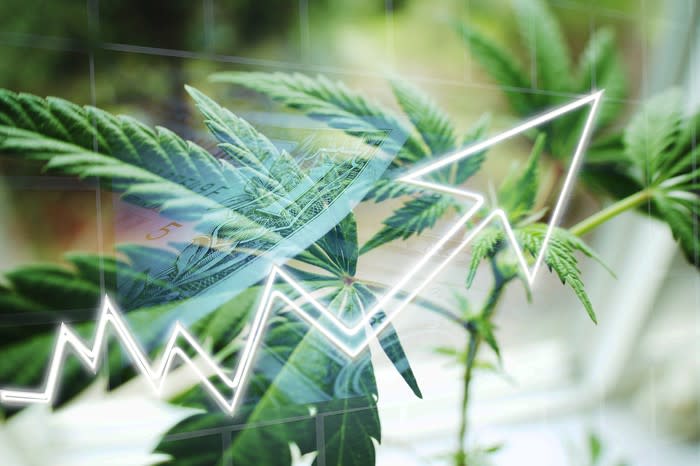Is Scotts Miracle-Gro a Buy?
If you are watching the meltdown of marijuana grower Tilray (NASDAQ: TLRY), you might be worrying that the excitement over pot stocks has crested. But even if that's true, it doesn't necessarily change the long-term growth potential of the sector. It may just mean that investors are getting more cautious about how they approach the burgeoning niche, which is where industry supplier Scotts Miracle-Gro (NYSE: SMG) comes in. Here's what you need to know about this company's foray into marijuana and whether or not it's worth buying.
Shifting gears, a little
For a very long time, Scotts was a boring company that sold lawn care products. That's a fairly stable business that grows slowly over time. Sure, it's seasonal, since lawns don't need much tending in the winter. Unusually hot or cold summers can cause temporary top- and bottom-line fluctuations. And every so often a new product comes out that's a big hit. But overall, not much happens in the lawn care sector.

Image source: Getty Images.
Then, a few years ago, Scotts decided to do something a bit more radical -- it jumped on the marijuana legalization bandwagon. Sticking to its roots, however, it chose to build a hydroponics business. So the goal is to be a supplier to the marijuana industry, just like it is to the lawn care industry.
This picks-and-shovels approach is kind of boring when you compare it to the excitement of directly investing in a newly developing sector. In fact, the picks-and-shovels reference comes from gold rush days, when the people selling supplies to gold miners made more money than the gold miners. That was because there were far more people looking to be miners than there were successful miners. So Scotts' approach to the pot space is likely to be much safer than if it had tried to compete with growers.
One look at the chart of Tilray, which has fallen from a high of over $200 to around $40 in less than a year, is proof of the concept here. Noting, of course, that over the same span Scotts' stock is up nearly 50%. To be fair, over the past year Tilray is actually up 60% -- but that's only for those lucky enough to have bought exactly a year ago. If you got caught up in the hype and bought closer to the peak, you would be losing money.
An interesting idea, but...
From a big picture perspective, Scotts looks like a good way to play the marijuana space. It isn't all-in, since its lawn care segment remains its largest business at around 80% of revenue. That provides an offset if the marijuana market weakens. That said, the company's Hawthorne operations, which is what it calls its hydroponics division, saw growth of 139% through the first nine months of fiscal 2019. That was fueled by acquisitions, but clearly Scotts is participating materially in the expanding marijuana space. And if the rosy projections for the sector are even close to accurate, it will likely continue to benefit even if Wall Street sours on pot growers since demand for marijuana will mean increased demand for growing supplies.
The problem is when you dig a little further into the details. Note that Scotts is buying its way into the hydroponics space. That's a completely reasonable approach, since it is already a substantial industry. However, that has meant adding a material amount of debt to the balance sheet. At the end of the fiscal third quarter, long-term debt accounted for around two-thirds of the company's capital structure. To be fair, that's down notably from the fiscal first quarter when the figure stood at a very concerning 90% or so. Giving credit where credit is due, management has trimmed long-term debt by around 30% in a very short period of time.
Although leverage is still notable, the fact that it is getting back to more normal levels again (long-term debt was roughly 50% of the capital structure in 2014, before the aggressive acquisition binge), Scotts is looking far more interesting than it was just a few quarters ago. But acquisitions come with other risks. The company has already taken one-time charges to write down parts of its Hawthorne business when the acquisitions it made didn't pan out as expected. There's no way to tell if more write-offs will be needed since it's still early in this transition. And the most recent acquisition Scotts has made is still masking Hawthorne's underlying growth potential, making it hard to discern if the business is truly living up to expectations.
Not for the faint of heart
Scotts has improved its balance sheet enough that it looks like an appealing way to invest in the pot space without taking on all the risk of owning a marijuana grower. However, the company's efforts in the hydroponic space are still relatively new, and risks remain. Leverage, while lower than it was, is still a little high. And the one-time charges taken in fiscal 2018 suggest that management is still trying to get a handle on the business.
While more aggressive types might want to look at Scotts, most investors should probably give management a little more time to prove that its approach to the marijuana space is working out as planned. That will start to be more obvious when the company's acquisition binge has its one-year anniversary, and Hawthrone's organic growth rates will show the real strength, or weakness, in the business.
Reuben Gregg Brewer has no position in any of the stocks mentioned. The Motley Fool has no position in any of the stocks mentioned. The Motley Fool has a disclosure policy.
This article was originally published on Fool.com
